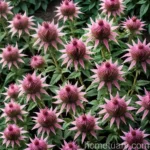Bee Balm (Monarda didyma ‘Pardon My Pink’)
What is Bee Balm?
Bee balm, scientifically known as Monarda didyma ‘Pardon My Pink’ is a charming perennial herb that belongs to the Lamiaceae family. It is native to eastern North America and is widely cultivated for its vibrant flowers and aromatic foliage. The distinctive inflorescences of bee balm make it a popular choice for pollinator gardens, as they attract bees, butterflies, and hummingbirds. Bee balm is not only an attractive addition to gardens, but it also holds several cultural, medicinal, and ecological uses.
Key Takeaways
Bee Balm (Monarda didyma ‘Pardon My Pink’)
- Family: Lamiaceae
- Common Name: Bee Balm
- Scientific Name: Monarda didyma ‘Pardon My Pink’
- Plant Type: Perennial
- Native: Eastern North America
Culture
Uses
Bee balm possesses several uses, making it a multifaceted plant in horticulture. Some of its uses include:
– Ornamental: Bee balm is primarily grown for its ornamental value. The vibrant pink flowers and aromatic foliage make it a beautiful addition to gardens, landscapes, and floral arrangements.
– Medicinal: The leaves of bee balm contain essential oils that are utilized in herbal medicine to treat various ailments.
– Ecological: The nectar-rich flowers attract pollinators, supporting the health and biodiversity of local ecosystems.
Water
- Needs: Bee balm thrives in moist soil, so it is essential to keep the plant adequately watered, especially during dry spells.
- Watering Frequency: Watering the plant once or twice a week is usually sufficient, but frequency may vary based on climate and soil conditions.
Sunlight
- Requirements: Bee balm thrives in full sun to partial shade. It is important to provide adequate sunlight for optimal growth and flowering.
Fertilizer
- Fertilization: Bee balm generally does not require heavy fertilization. However, using a balanced, slow-release fertilizer in spring can support healthy growth and prolific blooming.
Soil
- Type: Well-draining, fertile soil is best for bee balm. It is adaptable to various soil types but thrives in moist, loamy soil.
- pH: Bee balm prefers slightly acidic to neutral soil with a pH range of 6.0 to 7.0.
Pruning
- Pruning Time: Pruning bee balm is beneficial in early spring to promote bushier growth and enhance flowering.
- Techniques: Deadheading spent flowers and removing damaged or diseased stems are the primary pruning practices for bee balm.
Propagation
- Methods: Bee balm can be propagated through division, cuttings, or seed sowing.
- Division: Dividing mature clumps in early spring or fall helps rejuvenate the plant and increase its population.
Container Popularity
- Bee balm is a popular choice for container gardening due to its attractive flowers, compact growth habit, and suitability for attracting pollinators to limited spaces.
Common Diseases
Disease Diagnosis
While bee balm is generally resilient, it may occasionally be affected by fungal diseases such as powdery mildew and leaf spot. Proper diagnosis involves identifying symptoms such as:
– Powdery Mildew: White powdery patches on the foliage
– Leaf Spot: Dark spots on the leaves with yellow halos
Common Pests
Bee balm is relatively resistant to pest infestations, but it may attract spider mites and aphids in certain conditions, which can be managed using horticultural oils or insecticidal soaps.
Botanist’s Tips
- Companion Plants: Bee balm pairs well with Echinacea, Rudbeckia, and Salvia, creating a visually appealing and ecologically beneficial garden.
- Mulching: Applying a layer of organic mulch around bee balm helps retain moisture and suppress weeds.
- Attracting Pollinators: Planting bee balm alongside other nectar-rich plants can enhance its effectiveness in attracting and supporting pollinators.
Fun Facts
- The name “bee balm” reflects the plant’s attractiveness to bees, while the specific epithet “didyma” refers to the plant’s paired, opposite leaves.
- Bee balm was historically used by Native Americans as a herbal remedy for various ailments, including colds and digestive discomfort.
Links to External Resources
- Monarda didyma ‘Pardon My Pink’ – Missouri Botanical Garden
- Bee Balm – The Old Farmer’s Almanac
- Growing Bee Balm: How to Plant and Take Care of Bee Balm
- Bee Balm – FineGardening.com
In conclusion, bee balm (Monarda didyma ‘Pardon My Pink’) is a delightful and versatile plant that contributes to both the aesthetic appeal and ecological sustainability of gardens. Its vibrant flowers, easy cultivation, and multiple uses make it a valuable addition to any horticultural setting, showcasing the beauty and functionality of native flora in ornamental gardening and beyond.















